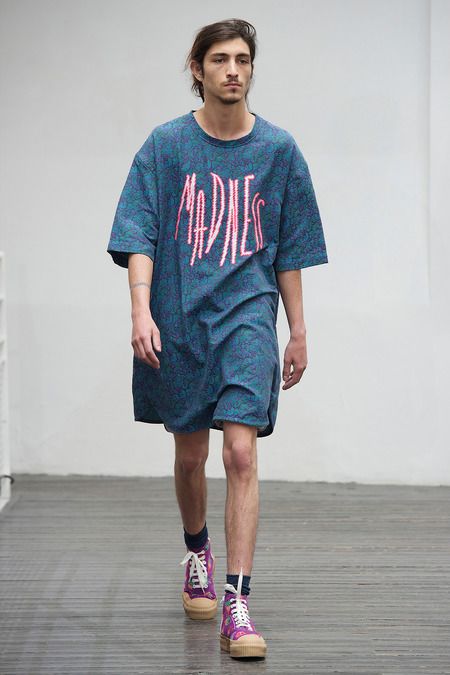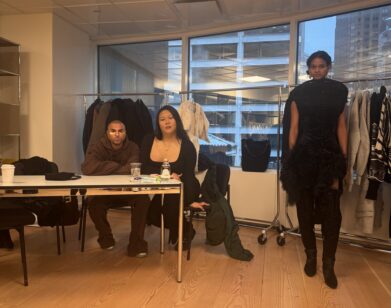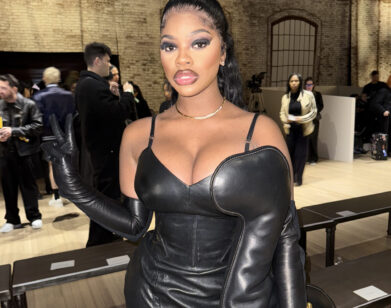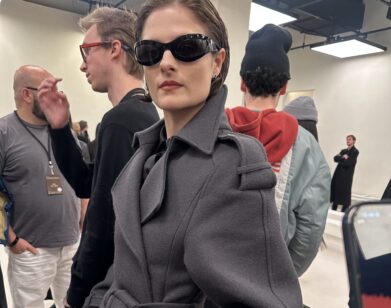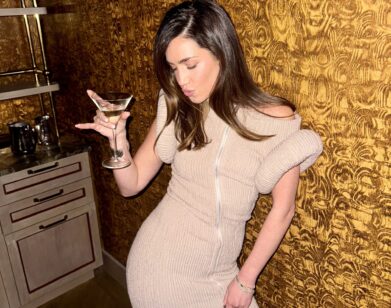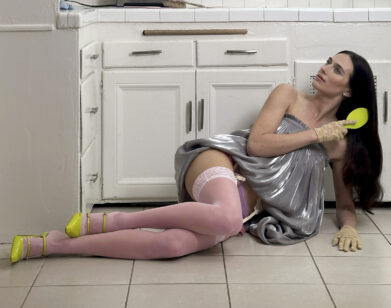Paris Menswear: Pictograms, Candy Wrappers, Living Rooms
The traveling eyes of international fashion set up shop in Paris yesterday for the last leg of the Spring/Summer 2014 menswear shows, an overflowing five days followed by the more ladylike Fall/Winter 2013/14 Haute Couture presentations—including women’s Resort shows—which begin Sunday night with Versace.
There’s an official schedule for Paris’s menswear shows, and then there’s a second layer of “by appointment” dates, which can reveal gems. That’s the case with 13 Bonaparte, David Sarfati’s emerging menswear label with a shop that opened late last year in the heart of the Marais at 2 bis rue de Normandie. The space, which includes 13 Bonaparte’s atelier and showroom, is whitewashed and spare in a chic French home way that evokes a beach bungalow in Cap Ferret (would that we should be so lucky).
Sarfati’s menswear combines what he has always liked about workwear—the canvas-type heavy cottons and Teflon for pants in classic, practical styles—but done in a much lighter more sophisticated way for elegant, urban men. Sarfati, 31, went straight to New York after school, where he consulted on packaging and concepts for cosmetics brands for three years before he was lured back to Paris to start 13 Bonaparte. (The collection’s name comes from his home address on Paris’ rue Bonaparte.) A marketing specialist, he works with a designer to develop the collection’s raglan-sleeve shirts, loose, shirt-like blousons in mixed shades of gray wool suiting, and those Teflon slacks—all of which are stand-outs in 13 Bonaparte’s Collection Three, currently in store.
Collection Four, which Sarfati considers more of an evolution than a new season, carries on with more of the same. For the moment, 13 Bonaparte is available only at its Paris shop, but top international stores keep returning to take a look, and Sarfati plans to add retail sales soon.
Julien David, the Frenchman who designs and produces his collection in Japan, is now a menswear star. His line is an extension of his own playful style; David has morphed the young Parisian’s cool effortless menswear ways with Japan’s more eclectic, colorful patterning. Imagine a French/Japanese chic Charlie Brown who favors a pictogram mix of tailoring and sportswear, and you’re getting the idea.
This season’s collection continues his young suits—a soft jacket with shorts—in pastel, mini-floral embroidered cotton jacquards. David’s graphics are cartoon style, but always provocative; and he puts them large and small into the collection as knit intarsias placed front and center on oversized sweaters, in repeat prints for shirts, and in great jacquards for giant tunic sweatshirts that look a bit like dresses. Julien David’s patterns this season cheerfully sum up the current state of the world: madness, peace, war, and an island paradise on the rolling sea with a lone palm tree.
Guillaume Henry’s Carven is cheerful, too. He’s a master at color—as evidenced by his collection’s first look, a brilliant ochre cropped overcoat over pale dusty green chinos. Henry fronted Carven’s sweaters with a smiling profile-sketch intarsia, offered up a new loose blouson with exposed zip in Day-Glo orange, redesigned Carven’s signature schoolbook bag as a clutch, put the boys in ladylike coat tailoring, and sent out all of them out in Carven’s fey, floppy silk hats.
Walter van Beirendonck has been on a roll for the past few seasons, making his audience wonder: Is the reason love, or the fact that Van Beirendonck has spread his wings as a fine artist as well as a costume designer (notably for last fall’s homage to Merce Cunningham at Paris Opera Ballet with Marie-Ange Gillot)? Or is it his pride as head of the fashion department at Antwerp’s Royal Academy of Arts, which will celebrate 50 years in fashion next September? After all, the Academy is where Van Beirendonck, as a graduate in the early 1980s, became part of the Antwerp Six, a group including Ann Demeulemeester, Dries Van Noten, Dirk Van Saene, Marina Yee, and Dirk Bikkembergs; with Martin Margiela as the seventh designer who went on to put Belgium on the international fashion map in the 1990s.
Van Beirendonck’s captivating “Home Sweet Home” collection, presented in the gilt splendor of Paris’s Opera Garnier Rotonde de Glacier, was a surreal tour de force. He turned jackets into paintings, featuring Scooter LaForge’s still lifes of an avant-garde home, in engineered prints with Little Bo Peep wickerwork caps by Stephen Jones. Occasionally the jackets went 3-D, as in a vase overflowing with crochet flowers, or a bib-front dress shirt striking out beyond the man with a gentleman’s chain watch placed at the side.
Van Beirendonck’s broad-shoudered jackets are spliced in precise geometric patchworks, as are his new boiler suits—fake two-pieces that merge sportswear and tailoring. The models, their wavy short hair covered in gold glitter, looked like a superhuman mix of Marcel Carné’s Les Enfants du Paradis (1945), and Devo, the stylized American New Wave band, in their early ’80s heyday.
Valentino’s Maria Grazia Chiuri and Pierpaolo Piccioli continue to combine the house’s impeccable atelier techniques with a chic sense of avant-garde taste, this time working minimalist military styling in solid-color tailoring (shirt, tie, and suit in exactly the same shade—practically the same fabric, in fact), or shades of gray and denim blue. Their shapes were punctuated by patch pockets, epaulettes, scoop necks, and standaway shapes. Valentino has turned abstract camouflage into a house specialty this season, overdying toile de jouy scenes in army olive and beige for windbreakers and slacks. Colorblocking here looks very modern in black leather pockets on olive canvas jackets, a technique that creates a spray-painted or taped-on effect.
Haider Ackermann’s style vocabulary is so universal that his new menswear collection almost seems like it has always been around. Low-slung trousers with fancy side stripes in unusual shades like lilac, sharp-waisted vests with contrast backs, scarf-like shirts tangled with silk fringed scarves, curvy tailored jackets with sleeves pushed up to the elbow, crossover kimono dressing gown coats, and loose blousons in shimmering, patterned silks, all strike a balance between tough and tender. The Haider Ackermann man moves from exotic street urchin to pampered little prince, with a smidgen of tattooed rockabilly swagger thrown in for good measure.
As if all this wasn’t enough for one day, the menswear faithful in Paris made the trek far out of town for Raf Simons’s show to Le Bourget’s avenue de l’Europe, home to Paris’s airstrip for private jets, where the Gagosian gallery has opened a cavernous annex. Simons, who loves contemporary art, has served as an art advisor in between collections in the early days of his label and just couldn’t resist putting his show in the midst of Gagosian’s current Calder/Prouvé exhibition, which juxtaposes Alexander Calder’s abstract art mobiles and Jean Prouvé’s full-scale Total Service station model from 1969. Prouvé is a perennial favorite among artists and fashion designers. Azzedine Alaïa, who attended the show, has one of his gas station models in his bedroom. It looked like Simons had been inspired by Prouvé and Calder for this groundbreaking collection of abstract menswear, which mixes simple athletic competition shapes in primary colors with the unisex look of baby rompers and space suits.
These body-flaunting pieces are covered with geometric signage and the bold graphics of Olympic sport competitions and product packaging, from candy wrappers to detergent and triathlons. The wrapper-art tunics made Simons’ boys look like grocery-store products crying out to be plucked from the shelf. Within this graphic sports frame, he managed to make shorts jumpsuits and tunics take on a dressy look—to further obscure the boundary between the sexes.

